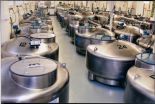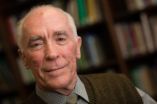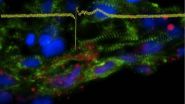(Press-News.org) Jena (Germany) Today, more than 500 million people are suffering from a lack of adequate protein in their diet. Each year, the number of human beings increases by 80 million, a figure which is equivalent to the present population of Germany. Thus, providing enough food, particularly sufficient protein for the increasing populace is a challenging task for societies all over the world. On a prospective basis, a progressively smaller proportion of human protein requirement can be provided by animal proteins such as meat, eggs, and milk. "However, by feeding valuable plant protein to animals, almost two third of it is wasted as it is transformed into animal protein," Professor Dr Gerhard Jahreis, nutritionist at Friedrich Schiller University Jena (Germany), says.
Rapeseed oil with its high nutritional value due to significant amounts of omega-3 fatty acids has gained a strong place in the human diet in recent years. Professor Jahreis comments: "Annually, 60 million tons of rapeseed are harvested worldwide, corresponding to about 15 million tons of rapeseed protein which is fed only to animals. We are taking a keen interest in making this important protein source available for human consumption." The research team at Jena University has now conducted the first human study worldwide on the use of rapeseed protein for human nutrition. Results from the study have recently been published in the internationally renowned journal "Clinical Nutrition" (http://dx.doi.org/10.1016/j.clnu.2012.11.005).
For the study, cold-pressed rapeseed oil was firstly produced under mild conditions. In cooperation with a Canadian Company, a protein isolate extracted from the residue was used in a study involving 28 volunteers. The study participants consumed either rapeseed protein isolate or soya protein isolate. After ingesting the protein meals, eight blood samples were drawn from each participant and the postprandial amino acid response in blood was analysed. Prof. Jahreis sums up: "Our findings have shown that there is no difference in the bioavailability between these two protein sources. Thus, soya, mostly cultivated in South and North America, and diversely used in the production of foods, can be fully replaced by rapeseed protein harvested in Europe."
Currently, legislation in Europe prevents the use of rapeseed protein for human nutrition. It requires registration as a "novel food" by the European Union. Ireland has already agreed to its use. In Germany, producers capable of isolating rapeseed protein are already waiting in the wings. The findings of the present study from the research group at the University of Jena represent a big step towards authorising approval of rapeseed protein for use in human nutrition.
INFORMATION:
Original publication:
Manja Fleddermann, Anita Fechner, Andrea Rößler, Melanie Bähr, Anja Pastor, Frank Liebert, Gerhard Jahreis (2013): Nutritional evaluation of rapeseed protein compared to soy protein for quality, plasma amino acids, and nitrogen balance - a randomized cross-over intervention study in humans. Clinical Nutrition, http://dx.doi.org/10.1016/j.clnu.2012.11.005.
Contact:
Prof. Dr. Gerhard Jahreis
Institute of Nutrition
Friedrich Schiller University Jena
Dornburger Straße 24, D-07743 Jena
Germany
Phone: +49 (0)3641 / 949610
Email: b6jage@uni-jena.de
Soya protein can be replaced by rapeseed protein
Nutritionists at Jena University point out an additional dietary protein source for humans
2013-01-28
ELSE PRESS RELEASES FROM THIS DATE:
Study of human specimen collections in the US offers first look at their huge diversity
2013-01-28
Chapel Hill, N.C. – Biobanks are organizations that collect, store and share human specimens (e.g., blood, solid tissues, hair) for research purposes. The rise of the human genome project and of large-scale genetics studies have spurred a dramatic increase in the number of biobanks in the last decade, increasing their importance in biomedical research.
But until now, biobanks in the U.S. have never been studied systematically, leaving few clear details as to how they are run or the policies and practices they use in managing their work.
A new study from the University ...
Discovering the missing 'LINC' to deafness
2013-01-28
Tel Aviv — Because half of all instances of hearing loss are linked to genetic mutations, advanced gene research is an invaluable tool for uncovering causes of deafness — and one of the biggest hopes for the development of new therapies. Now Prof. Karen Avraham of the Sackler Faculty of Medicine at Tel Aviv University has discovered a significant mutation in a LINC family protein — part of the cells of the inner ear — that could lead to new treatments for hearing disorders.
Her team of researchers, including Dr. Henning Horn and Profs. Colin Stewart and Brian Burke of ...
With hot air treatment, bacteria fly the coop
2013-01-28
This press release is available in Spanish.Poultry producers can reduce bacterial cross-contamination in poultry cages by treating the cages with forced air that's been heated to 122 degrees Fahrenheit, according to a study by U.S. Department of Agriculture (USDA) scientists.
While being transported in coops on trucks, poultry that have bacteria such as Campylobacter can contaminate, through their feces, other poultry that are free of pathogens. Those disease-causing bacteria can then be passed on to the next group of birds during the next trip, and so forth, unless ...
Islet transplant may slow progression of atherosclerosis
2013-01-28
Minimally invasive islet transplantation for patients with type 1 diabetes achieves insulin independence and reverses the progression of atherosclerosis in the first few years after transplant, according to a University of Illinois at Chicago study.
The research is published in the February issue of the journal Diabetes Care and is available online.
Patients with diabetes, particularly women, have a substantial increased risk of dying from ischemic heart disease, according to previous research. However, future cardiac events may be prevented with intensive glycemic ...
Central Valley irrigation intensifies rainfall, storms across the Southwest
2013-01-28
Irvine, Calif., Jan. 28, 2013 – Agricultural irrigation in California's Central Valley doubles the amount of water vapor pumped into the atmosphere, ratcheting up rainfall and powerful monsoons across the interior Southwest, according to a new study by UC Irvine scientists.
Moisture on the vast farm fields evaporates, is blown over the Sierra Nevada and dumps 15 percent more than average summer rain in numerous other states. Runoff to the Colorado River increases by 28 percent, and the Four Corners region experiences a 56 percent boost in runoff. While the additional ...
Safeguards needed for tissue donors
2013-01-28
Donors to biobanks – vast collections of human tissue samples that scientists hope will lead to new treatments for diseases – have a right to basic information about how their donations may be used, a Michigan State University ethicist argues in a new paper.
The idea behind biobanks is that a repository with hundreds of thousands of samples, each linked to medical records and other health information, can yield discoveries smaller data sets can't match. Once samples are collected, researchers in many fields can use the data repeatedly.
"More and larger biobanks are ...
New LGBT Health journal launching in 2013
2013-01-28
New Rochelle, NY, January 28, 2013—Over 4 million adults in the United States identify as gay, lesbian, or bisexual and approximately 700,000 identify as transgender. An NIH-sponsored investigation by the Institute of Medicine (IOM) concluded that the health status and healthcare needs of this sizable population are poorly understood and likely inadequately met. A journal is urgently needed to support, promote, and address the unique healthcare needs of each population that comprises the LGBT community, in the United States and worldwide. LGBT Health, a new peer-reviewed ...
Best friends influence when teenagers have first drink
2013-01-28
Chances are the only thing you remember about your first swig of alcohol is how bad the stuff tasted. What you didn't know is the person who gave you that first drink and when you had it says a lot about your predisposition to imbibe later in life.
A national study by a University of Iowa-led team has found that adolescents who get their first drink from a friend are more likely to drink sooner in life, which past studies show makes them more prone to abusing alcohol when they get older. The finding is designed to help specialists predict when adolescents are likely to ...
Patients' own skin cells are transformed into heart cells to create 'disease in a dish'
2013-01-28
LA JOLLA, Calif., January 27, 2013 – Most patients with an inherited heart condition known as arrhythmogenic right ventricular dysplasia/cardiomyopathy (ARVD/C) don't know they have a problem until they're in their early 20s. The lack of symptoms at younger ages makes it very difficult for researchers to study how ARVD/C evolves or to develop treatments. A new stem cell-based technology created by 2012 Nobel Prize winner Shinya Yamanaka, M.D., Ph.D., helps solve this problem. With this technology, researchers can generate heart muscle cells from a patient's own skin cells. ...
Demagnetization by rapid spin transport
2013-01-28
For purposes of their research, the scientists irradiated two separate layered systems with ultrashort laser pulses on the order of just one hundred femtoseconds (10-15 s). One sample consisted essentially of a single thin layer of ferromagnetic nickel. By contrast, a second sample of this same nickel material was coated with a non-magnetic layer of gold. Only a mere 30 nanometers (10-9 m) thick, the gold layer swallowed up the lion's share of the laser light so that barely any light ended up reaching the nickel layer. In spite of this, the nickel layer's magnetization ...
LAST 30 PRESS RELEASES:
Heart-brain connection: international study reveals the role of the vagus nerve in keeping the heart young
Researchers identify Rb1 as a predictive biomarker for a new therapeutic strategy in some breast cancers
Survey reveals ethical gaps slowing AI adoption in pediatric surgery
Stimulant ADHD medications work differently than thought
AI overestimates how smart people are, according to HSE economists
HSE researchers create genome-wide map of quadruplexes
Scientists boost cell "powerhouses" to burn more calories
Automatic label checking: The missing step in making reliable medical AI
Low daily alcohol intake linked to 50% heightened mouth cancer risk in India
American Meteorological Society announces Rick Spinrad as 2026 President-Elect
Biomass-based carbon capture spotlighted in newly released global climate webinar recording
Illuminating invisible nano pollutants: advanced bioimaging tracks the full journey of emerging nanoscale contaminants in living systems
How does age affect recovery from spinal cord injury?
Novel AI tool offers prognosis for patients with head and neck cancer
Fathers’ microplastic exposure tied to their children’s metabolic problems
Research validates laboratory model for studying high-grade serous ovarian cancer
SIR 2026 delivers transformative breakthroughs in minimally invasive medicine to improve patient care
Stem Cell Reports most downloaded papers of 2025 highlight the breadth and impact of stem cell research
Oxford-led study estimates NHS spends around 3% of its primary and secondary care budget on the health impacts of heat and cold in England
A researcher’s long quest leads to a smart composite breakthrough
Urban wild bees act as “microbial sensors” of city health.
New study finds where you live affects recovery after a hip fracture
Forecasting the impact of fully automated vehicle adoption on US road traffic injuries
Alcohol-related hospitalizations from 2016 to 2022
Semaglutide and hospitalizations in patients with obesity and established cardiovascular disease
Researchers ‘listen in’ to embryo-mother interactions during implantation using a culture system replicating the womb lining
How changing your diet could help save the world
How to make AI truly scalable and reliable for real-time traffic assignment?
Beyond fragmented markets: A new framework for efficient and stable ride-pooling
Can shape priors make road perception more reliable for autonomous driving?
[Press-News.org] Soya protein can be replaced by rapeseed proteinNutritionists at Jena University point out an additional dietary protein source for humans




